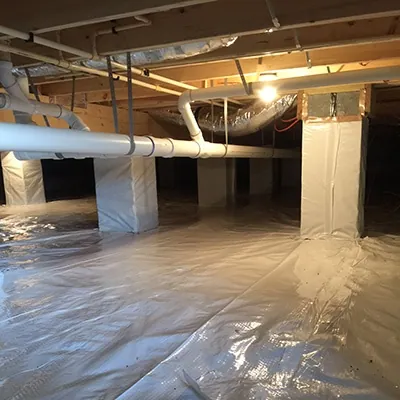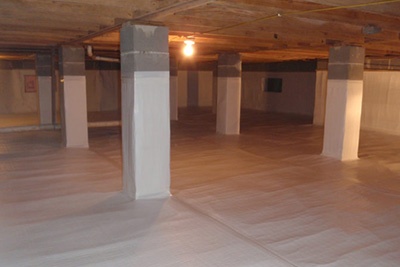Updated on April 25, 2025
Every Virginia home, especially an older one, has hard-to-reach places that homeowners rarely think about. The saying “out of sight, out of mind” rings true, especially for crawl spaces. But these often-forgotten areas can have a positive impact on your home’s comfort, energy bills, and indoor air quality when properly insulated.
Why Crawl Space Insulation Matters

According to the U.S. Department of Energy, insulating your crawl space properly can boost your home’s energy efficiency, improve comfort, reduce allergens, and even make your home more durable.
Benefits include:
- Energy savings-Save up to 15–20% in reduced heating and cooling costs, thanks to reduced stress on your HVAC system.
- Moisture control– Helps to prevents mold growth and wood rot in our humid climate.
- Home comfort– Enjoy more even temperatures across your living space.
- Health and durability– Improves indoor air quality, lets in fewer pollutants, and protects your home’s foundation.
Sealed vs. Vented Crawl Spaces
In Virginia, our homes have two types of crawl spaces:
Vented crawl spaces
This type of crawl space is very common in Virginia. They have vents that lead to the outside that can easily bring in humid summer air, causing condensation and contributing to rot and mold growth. These spaces require ground vapor barriers (also known as encapsulation) and insulation on the crawl space floor.
Sealed crawl spaces
Also known as conditioned crawl spaces, they are closed off and treated as part of your heated and cooled home. They need wall insulation, a vapor barrier, and humidity control.
Experts agree that sealed, or non-vented, crawl spaces offer better moisture control, lower material costs, and protect ducts and pipes. It’s also important to ensure you have an effective drainage system, such as a sump pump, to keep your crawl space dry before installing insulation.
2025 Virginia Building Code Requirements
As of January 2025, Virginia solely follows the energy standards in the 2021 Virginia Residential Building Code. These rules require builders and homeowners to install insulation in new homes based on which type of crawl space their home has:
- Vented crawl spaces need a minimum R-value of insulation between the floor joists to keep the upper areas of your home energy efficient.
- Non-vented (conditioned) crawl spaces need insulation along the foundation walls and a vapor barrier on the ground.
Since most of our state falls in Climate Zone 4A, with hot summers and moderately cold winters, insulating your crawl space is even more important. Thankfully, many homeowners are choosing to insulate their crawl spaces to bring them up to code.
Best Insulation Options for Virginia
There are several effective products you can choose to insulate your crawl space. Choosing the right insulation option depends on your crawl space type and needs.
Closed-cell spray foam
Works well in tight spots and on rim joists, offering both air sealing, insulation and a high R-value.
Fiberglass batts
Common for vented spaces but must be secured properly to prevent sagging. Use unfaced batts for the best performance.
Foam board insulation
Also known as rigid foam, it’s another popular choice for sealed crawl space walls. It resists moisture and offers a high R-value.
Plus, don’t forget to insulate any access doors and hatches because they’re often overlooked.
Valuable Resources to Explore
Before insulating or encapsulating your crawl space, be sure to reach out to a qualified contractor, such as Toler Insulating, for expert advice on local building codes and the scope of work that’s needed to successfully complete the job. Check out these valuable resources for more information on crawl spaces:
- Department of Energy- Building America Solution Center
- Crawl Space Ninja- Is Crawl Space Insulation Necessary?
- Environmental Protection Agency- Moisture Control Resource
Your Crawl Space Insulation Experts
Don’t let your crawl space be an afterthought. With proper sealing and insulation, you’ll enjoy lower energy bills, a more comfortable home, and peace of mind. At Toler Insulating, we’ve been working alongside Lynchburg homeowners and residential contractors since 1994, providing top-quality crawl space insulation solutions. We’re here to answer your questions! Contact us today to schedule your free crawl space evaluation. Your home and your future utility bills will thank you.
References
Building America Solution Center. (n.d.). Unvented, insulated crawlspaces. Retrieved from https://basc.pnnl.gov/resource-guides/unvented-insulated-crawlspaces
Department of Energy. (n.d.). Building America top innovations hall of fame profile – Unvented crawlspaces code adoption. Retrieved from https://www.energy.gov/eere/buildings/articles/unvented-crawlspace-code-adoption-building-america-top-innovation
Department of Energy. (n.d.). Where to insulate in a home. Retrieved from https://www.energy.gov/energysaver/where-insulate-home
ENERGY STAR. (n.d.). Crawlspace insulation. Retrieved from https://www.energystar.gov/sites/default/files/asset/document/Technology%20Fact%20Sheet%20Crawlspace%20Insulation.pdf
Environmental Protection Agency. (n.d.). What are the main ways to control moisture in your home? Retrieved from https://www.epa.gov/mold/what-are-main-ways-control-moisture-your-home
Insulation Institute. (n.d.). Floor insulation requirements. Retrieved from https://insulationinstitute.org
Timber Sill. (n.d.). 10 crawl space codes (2025 requirements). Retrieved from https://timbersill.com/building-code/crawl-space-code/
Town of West Point. (n.d.). Virginia residential building code changes. Retrieved from https://www.west-point.va.us/news_detail_T2_R59.php
Virginia Law. (n.d.). 13VAC5-63-264. Chapter 13 Energy efficiency. Retrieved from https://law.lis.virginia.gov/admincode/title13/agency5/chapter63/section264/
Viridiant. (n.d.). N1102.2.10 (R402.2.10) Crawl space walls. Retrieved from https://viridiant.org
